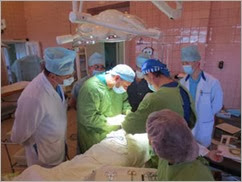Published: Jan 5, 2014
By Cole Petrochko, Staff Writer, MedPage Today
Surgical resection of huge hepatocellular carcinomas was linked with better survival outcomes versus transarterial chemoembolization (TACE), researchers found.
Surgical resection as the first treatment for huge hepatocellular carcinomas was associated with higher 1-, 2-, and 3-year overall survival rates (69.7%, 58.6%, and 51.7%, respectively) compared with TACE (40.2%, 33.9%, and 18.5%, respectively), according to Moon Seok Choi, MD, PhD, of Sungyunkwan University School of Medicine in Seoul, Korea, and colleagues.
In a multivariate analysis, characteristics positively associated with survival included albumin (hazard ratio 0.54, 95% CI 0.34-0.85, P=0.008) and surgical resection (HR 0.44, 95% CI 0.28-0.70, P=0.001), they wrote online in Clinical Hepatology.
Characteristics adversely associated with survival included male sex (HR 1.90, 95% CI 1.01-3.58, P=0.048) and ascites (HR 1.77, 95% CI 1.02-3.08, P=0.044), they added.
The authors noted that patients presenting with huge tumors -- 10 cm or greater in diameter -- have worse survival than those with smaller tumors. Past research has shown that ablative treatment followed by a waiting period was superior to rapid transplantation.
But resection of huge carcinomas is "technically difficult and usually requires major hepatic resection, which can be associated with an increased risk of operative mortality," the current researchers stated.
They compared long-term outcomes for surgical resection versus TACE for huge hepatocellular carcinoma and evaluated potential prognostic factors tied to survival. Resection was performed in 84 patients and TACE was performed in 267 patients from 2000 to 2009.
The primary endpoint was overall survival (OS). Additional outcomes included prognostic factors for OS, and were explored through univariate and multivariate analyses in the propensity score-matched cohort.
Researchers gathered age, sex, liver disease etiology, presence of cirrhosis, and Child-Pugh class data, as well as tumor size, number, extent, and vessel invasion data.
A propensity score-matched cohort was formed with 76 patients matched by age, sex, liver disease etiology, Child-Pugh class, tumor number, presence of vessel invasion, and tumor extent.
Patients who were treated with surgery received follow-up at 3-month intervals for the first 2 years and then every 6 months after, where they underwent liver function tests, serum AFP level measurement, and dynamic liver CT to scan for recurrence.
Those who received TACE underwent two consecutive sessions at 1-month intervals, followed by an outpatient clinic visit 1 month after each treatment cycle, where they received a similar battery of tests to determine tumor status. The chemoembolization was repeated "if clinically feasible and viable tumor was present on the dynamic liver CT."
In-hospital mortality between treatment groups did not differ significantly (P=0.14). Two patients who underwent surgical resection died of liver failure during the same hospital admission, while a single patient who received TACE died of lipiodol-induced acute lung injury.
Prior to propensity score matching, those treated surgically had better 1-, 3-, and 5-year OS than those treated with TACE at 10 months of follow-up (P<0.001).
The authors cautioned that although survival was greater at 1, 3, and 5 years among those treated surgically, that group "had less patients with liver cirrhosis and less patients with portal vein or hepatic vein invasion than the nonsurgical treatment group."
They added that "it remains possible that patients selection factors may have influenced the results, which limits the usefulness of this study."
They also noted that the study was limited by retrospective design, small number of patients, and the inclusion of vessel invasion into matching but not the extent of invasion.
The authors declared that they had no conflicts of interest.
Primary source: Clinical Hepatology
Source reference: Choi MS, et al. "Long-term survival after surgical resection for huge HCC: comparison with TACE after propensity score matching" Clinical Hepatology 2013.

No comments:
Post a Comment